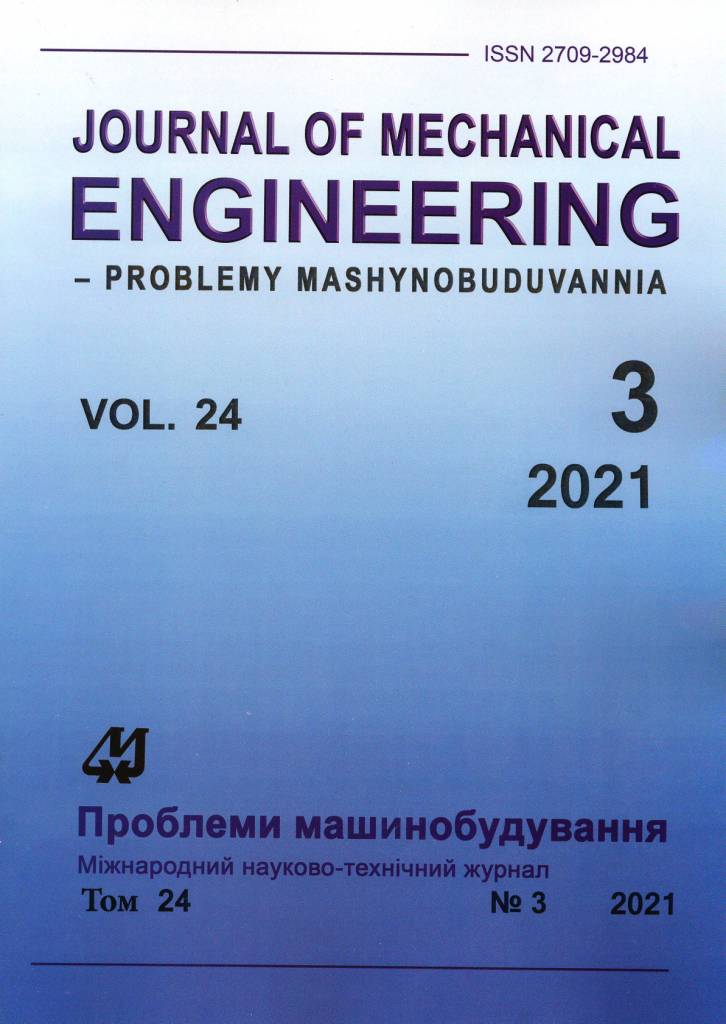Контактна взаємодія елементів внутрішнього корпусу парової турбіни при пластичному деформуванні
Анотація
Вивчається питання впливу пластичності матеріалів конструкції на характер контактної взаємодії її елементів під час експлуатації. Розв’язується задача про напружено-деформований стан внутрішнього корпусу циліндра високого тиску парової турбіни, розрахованої на надкритичні параметри пари (понад 240 ата і 565 °С). Розв’язання задачі здійснюється шляхом використання скінченно-елементного програмного комплексу. Розглянуто модель термопластичності з кінематичним та ізотропним зміцненням. Під час проведення дослідження для матеріалів з’єднання використано експериментальні криві деформування. Наведено основні залежності, що використовуються при розв’язанні поставленої задачі. Методика розв'язання термоконтактної задачі взаємодії елементів фланцевого з’єднання в умовах пластичності базується на застосуванні моделі контактного шару. Для можливості врахування змін навантаження від кріплення в процесі спільної деформації як кріплення, так і корпусу вперше запропоновано методику тривимірного моделювання термозатяжки кріплення горизонтального роз’єму корпусу завдяки застосуванню наведеного коефіцієнта лінійного розширення матеріалу. Запропонований підхід дозволяє моделювати напруження початкової затяжки шпильок шляхом задання фіктивної зміни (зменшення) коефіцієнта лінійного розширення шпильки, заданої як окреме тіло в розрахунковій схемі. Величина зазначеної зміни коефіцієнта лінійного розширення визначена із залежності між напруженням початкової затяжки в шпильці і необхідним для його створення видовженням, реалізованим в розрахунковій схемі наявністю різних величин лінійного розширення шпильки і корпусу. Для проведення чисельного експерименту побудовано впорядковану скінченно-елементну сітку моделі корпусу. При побудові сітки елементів корпусу та кріплення використано 20-вузловий скінченний елемент. Враховується дія силових навантажень та температурного поля, в якому експлуатується елемент конструкції, що розглядається. Проведено аналіз результатів розподілу еквівалентних напружень та контактного тиску під час експлуатації. Відзначено відмінність отриманих результатів порівняно з результатами розв’язання задачі в пружній постановці.
##submission.downloads##
Опубліковано
Номер
Розділ
Ліцензія
Авторське право (c) 2021 С. А. Пальков, И. А. Пальков

Ця робота ліцензується відповідно до Creative Commons Attribution-NoDerivatives 4.0 International License.
Автори, які публікуються в цьому журналі, погоджуються з наступними умовами:
- Автори залишають за собою право на авторство своєї роботи і передають журналу право першої публікації цієї роботи на умовах ліцензійного договору (угоди).
- Автори мають право самостійно укладати додаткові договори (угоди) з неексклюзивного поширення роботи в тому вигляді, в якому вона була опублікована цим журналом (наприклад, розміщувати роботу в електронному сховищі установи або публікувати в складі монографії), за умови збереження посилання на першу публікацію роботи в цьому журналі.
- Політика журналу дозволяє розміщення авторами в мережі Інтернет (наприклад, у сховищах установи або на персональних веб-сайтах) рукопису роботи як до подачі цього рукопису в редакцію, так і під час її редакційної обробки, оскільки це сприяє виникненню продуктивної наукової дискусії і позитивно позначається на оперативності та динаміці цитування опублікованої роботи (див. The Effect of Open Access).

